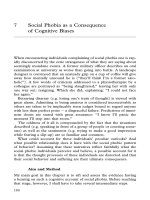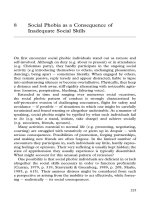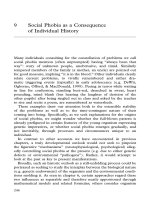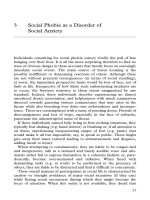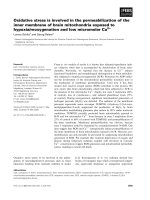Hydrogen peroxide as a potential biomarker of oxidative stress is there a reliable assay
Bạn đang xem bản rút gọn của tài liệu. Xem và tải ngay bản đầy đủ của tài liệu tại đây (1.4 MB, 165 trang )
HYDROGEN PEROXIDE AS A POTENTIAL BIOMARKER
OF OXIDATIVE STRESS:
IS THERE A RELIABLE ASSAY?
MOHAMED SAH REDHA BIN HAMZAH
B.Sc.(Hons.) in Chemistry
A THESIS SUBMITTED
FOR THE DEGREE OF MASTER OF SCIENCE
DEPARTMENT OF BIOCHEMISTRY
NATIONAL UNIVERSITY OF SINGAPORE
2007
ACKNOWLEDGEMENTS
I would like to convey my deepest and most sincere appreciation to the following people
from the NUS Department of Biochemistry:
Professor Barry Halliwell for his great patience and useful guidance throughout my
project despite his hectic schedule; and most importantly, for providing me with the
golden opportunity to be part of his research team;
Ms. Long Lee Hua for providing me with the necessary resources;
Dr Tang Soon Yew for his valuable opinions and generous sharing of knowledge;
Assist. Prof. Andrew Jenner for being approachable for advice;
Dr Jan Gruber, Sherry Huang, Wang Huansong, Mary Ng Pei Ern, Chu Siew Hwa,
Siau Jia Ling and Li Lingzhi, for their precious contributions to the project; and
Prof. Sit Kim Ping and Dr Jetty Lee for their cheerful smiles.
I would like to present this work to my parents, and thank them for their love and
encouragement. To Andrew Tan Kong Hui, thanks for your support too!
Through this journey with the Oxidants and Antioxidants Group, I have cultivated the
habit of including fruits and vegetables in my previously unbalanced diet. And I have
found out that 100% atmospheric oxygen is not going to help me be a better athlete.
i
TABLE OF CONTENTS
Page
Acknowledgements
i
Table of contents
ii
Abstract
vi
List of tables
viii
List of figures
x
List of abbreviations and keywords
xii
CHAPTER 1. INTRODUCTION
1.1. Free Radicals And Reactive Species
1
1.2. Reactive Oxygen Species: Formation
2
1.3. The Good Side Of Reactive Oxygen Species
6
1.4. Antioxidant Defences
8
1.5. Oxidative Stress: The Bad Side Of Reactive Oxygen Species
9
1.6. Use Of Biomarkers In Oxidative Stress Measurement
10
1.7. Hydrogen Peroxide As A Biomarker Of Oxidative Stress
14
1.8. Potential Problems In Hydrogen Peroxide Measurement
16
1.9. Importance Of A Good Analytical Technique
17
1.10. Objectives Of Present Study
18
CHAPTER 2. EXPERIMENTAL PROCEDURES
2.1. Materials
ii
2.1.1. Reagents and instrumentation
19
2.1.2. Human subjects
20
2.1.3. Preparation of beverages
21
2.2. Methods
2.2.1. Preparation of hydrogen peroxide standards
21
2.2.2. Preparation of human subjects
22
2.2.3. Oxygen electrode assay
22
2.2.4. Recovery study for oxygen electrode assay
23
2.2.5. Study of ascorbate effect on oxygen electrode assay
24
2.2.6. Ferrous ion oxidation- xylenol orange version 2 (FOX-2) assay
25
2.2.7. Recovery study for FOX-2 assay
26
2.2.8. FeTMPyP-catalysed indamine dye formation assay (FeTMPyP assay)
26
2.2.9. Recovery study for FeTMPyP assay
28
2.2.10. Pentafluorobenzenesulfonyl fluorescein (PFBSF) assay
28
2.2.11. Homovanillic acid (HVA) assay
29
2.2.12. p-Hydroxyphenyl acetic acid (HPAA) assay
29
2.2.13. 2,2’-Azino-bis(3-ethylbenzothiazoline-6-sulfonic acid) assay [ABTS
assay]
30
2.2.14. Preformation of ABTS+• and the quenching effect of urine
30
2.2.15. N-Acetyl-3,7-dihydroxyphenoxazine (amplex red) assay
31
2.2.16. Recovery study for amplex red assay
32
2.2.17. 2’,7’-Dichlorodihydrofluorescein (DCFH) assay
33
2.2.18. Recovery study for 2’,7’-dichlorodihydrofluorescein (DCFH) assay
34
iii
2.2.19. Monitoring the progress of DCFH assay and the effect of catalase and
SOD
34
2.2.20. Dihydrorhodamine 123 (DHR) assay
35
2.2.21. Recovery study for dihydrorhodamine 123 (DHR) assay
36
2.2.22. Basal urinary hydrogen peroxide measurements in human subjects
36
2.2.23. Coffee drinking study
36
2.2.24. Creatinine assay
37
CHAPTER 3. RESULTS
3.1. Catalase-Based Electrochemical Method
3.1.1. Oxygen electrode assay
38
3.2. Non-Enzymatic Chemical-Based Methods
3.2.1. Ferrous ion oxidation- xylenol orange version 2 (FOX-2) assay
46
3.2.2. FeTMPyP-catalysed indamine dye formation assay (FeTMPyP assay)
57
3.2.3. Pentafluorobenzenesulfonyl fluorescein (PFBSF) assay
65
3.3. Peroxidase-Based Methods
68
3.3.1. Homovanillic acid (HVA) assay
69
3.3.2. p-Hydroxyphenyl acetic acid (HPAA) assay
73
3.3.3. 2,2’-Azino-bis(3-ethylbenzothiazoline-6-sulfonic acid) assay [ABTS
assay]
76
3.3.4. N-Acetyl-3,7-dihydroxyphenoxazine (amplex red) assay
83
3.3.5. 2’,7’-Dichlorodihydrofluorescein (DCFH) assay
92
3.3.6. Dihydrorhodamine 123 (DHR) assay
103
3.4. Basal Urinary Hydrogen Peroxide Measurements
109
iv
3.5. Effect Of Coffee On Basal Urinary Hydrogen Peroxide
112
CHAPTER 4. FURTHER DISCUSSION
114
CHAPTER 5. CONCLUSION
131
CHAPTER 6. REFERENCES
132
v
ABSTRACT
Oxidative stress causes damage to the critical biomolecules in humans. When left
unchecked, it contributes to the development of several diseases such as cancer, diabetes,
cardiovascular diseases, neurodegenerative disorders and even to the process of ageing
itself. Considerable debate over identifying the best biomarkers of oxidative stress is still
ongoing. Good biomarkers like F2-isoprostanes have been proposed to be among the most
reliable but they require the use of expensive instrumentation and extensive preparation
steps. But hydrogen peroxide (H2O2) can be easily detected in freshly-voided human
urine, without the need for costly set-ups, and it has been proposed as a biomarker of
oxidative stress. Obtaining urine also does not require an invasive sampling procedure. In
order to investigate how well H2O2 fits into the criteria of an ideal biomarker, an assay
that is highly specific, sensitive and reproducible for urinary H2O2 measurement is first
required. In the present study, current methods of H2O2 measurement in urine samples
(by FOX-2 and oxygen electrode assays) were examined, and various other peroxidasebased and non-enzymatic, chemical-based methods were developed and tested for their
suitability to measure H2O2 in urine. The classical oxygen electrode assay and the newlydeveloped, DCFH peroxidase-based assay emerged to be the two most reliable methods.
The DCFH assay was able to detect a basal level of H2O2 excreted by healthy individuals,
with less intra-individual variation throughout the day and between different days than
with the oxygen electrode assay. In future, urinary H2O2 can be further studied with the
DCFH assay, alongside other classical biomarkers of oxidative stress, in known
pathological conditions and to see the effect of intervention of these conditions with
vi
antioxidant therapy. Hence, the importance of a good analytical technique can never be
overemphasized; in the study of biomarkers of oxidative stress, any data would be
meaningless if the method that generates them is not suitable for that application.
vii
LIST OF TABLES
Page
1.1. Nomenclature of reactive species found in vivo
1
1.2. Biomarkers of oxidative stress/damage associated with some human
diseases
14
1.3. Data of urinary hydrogen peroxide analyzed by 3 different ways
16
3.1. Accuracy of determination of PBS solutions of H2O2 by the O2 electrode
assay
41
3.2. O2 electrode assay recovery study
42
3.3: First study of ascorbate effect on O2 electrode assay
43
3.4: Second study of ascorbate effect on O2 electrode assay
45
3.5. FOX-2 assay recovery study
48
3.6. Comparison of FOX-2 assay with O2 electrode assay in one individual
50
3.7. Comparison of FOX-2 Assay with O2 electrode assay in a few individuals
51
3.8. Effect of dilution of urine sample on FOX-2 assay
53
3.9. Comparison of 10xD-FOX-2 assay with O2 electrode assay
54
3.10. 10xD-FOX-2 assay recovery study
55
3.11. FeTMPyP assay recovery study
61
3.12. Effect of dilution of urine sample on HVA assay
71
3.13. HVA assay: fluorescence in different mixtures
72
3.14. Effect of dilution of urine sample on HPAA assay
74
3.15. ABTS assay: sample absorbance data
79
3.16. Quenching effect of urine on preformed ABTS+•
80
3.17. Effect of dilution of urine sample on amplex red assay
85
viii
3.18. Amplex red assay recovery study
87
3.19. Comparison of the amplex red assay with O2 electrode assay in a few
individuals
88
3.20. Effect of dilution of urine sample on DCFH assay
94
3.21. DCFH assay recovery study
96
3.22. Comparison of the DCFH assay with O2 electrode assay in a few
individuals
99
3.23. Coefficient of variation of various urine samples analyzed by DCFH assay
100
3.24. Effect of dilution of urine sample on DHR assay and comparison with
DCFH assay
106
3.25. DHR assay recovery study and comparison with DCFH assay
107
3.26. Variations in H2O2 level throughout the day as measured by two assays
(DCFH and O2 electrode)
111
3.27. Effect of coffee consumption on urinary H2O2 concentration
113
ix
LIST OF FIGURES
Page
1.1. Molecular orbital diagram of dioxygen
2
1.2. Pathways of ROS formation, the lipid peroxidation process and the role of
glutathione and other antioxidants – Vitamin E, Vitamin C, lipoic acid – in the
management of oxidative stress
4
1.3. ROS-induced MAPK signaling pathways
7
1.4. Chemical structure of (a) 8-hydroxy-2’-deoxyguanosine (8OHdG) and (b) 8iso-Prostaglandin F2α
12
3.1. O2 electrode chart recording
38
3.2. A standard calibration plot for the O2 electrode assay
40
3.3. A standard calibration plot for the FOX-2 assay
47
3.4. Structures of (a) hemin and (b) FeTMPyPCl5
57
3.5. Coupling reaction to form indamine dye
58
3.6. Absorbance progress of the FeTMPyP-catalyzed indamine dye formation
reaction
58
3.7. A standard calibration plot for the FeTMPyP assay
60
3.8. FeTMPyP reaction scheme
63
3.9. Pentafluorobenzenesulfonyl fluorescein (PFBSF)
65
3.10. Oxidation of HVA in the presence of HRP to a fluorescence dimer
69
3.11. A standard calibration plot for the HVA assay
70
3.12. A standard calibration plot for the HPAA assay
74
3.13. Structure of ABTS and its oxidation products
76
3.14. A standard calibration plot for the ABTS assay
78
3.15. Chemical structures of polyphenols and their metabolites detected in urine
81
x
3.16. Mechanism of action for (a) ABTS/HRP/ H2O2 and (b) ascorbic acid (AA)
with ABTS+•
82
3.17. A standard calibration plot for amplex red assay
84
3.18. HRP-catalyzed amplex red oxidation by H2O2
89
3.19. Structures of some peroxidase substrates
91
3.20. A standard calibration plot for DCFH assay
93
3.21. Fluorescence intensity progress of the DCFH/HRP reaction with 0 to 10
µM H2O2 standards
97
3.22. Fluorescence intensity progress of the DCFH/HRP reaction in 2 urine
samples (S1 & S2)
102
3.23. Oxidation of dihydrorhodamine 123 (DHR) to rhodamine 123
103
3.24. A standard calibration plot for DHR assay
104
4.1. Mechanism of DCFH-DA de-esterification to DCFH and further oxidation
to highly-fluorescent DCF by ROS and RNS
121
4.2. Schematic representation of DCFH oxidation by HRP initiated by H2O2
123
4.3. Chemical structure of scopoletin
126
4.4. Comparison of structures of HFLUOR (dihydrofluorescein) and DCFH
(2’,7’-dichlorodihydrofluorescein), as well as their oxidized products
130
4.5. Molecular structures of ascorbic acid quenchers (AAQs)
130
xi
LIST OF ABBREVIATIONS AND KEYWORDS
AA
Ascorbic acid
AAQ
Ascorbic acid quencher
ABTS
2,2’-Azino-bis(3-ethylbenzothiazoline-6-sulfonic acid
AscH-
Ascorbate
CuZnSOD
Copper and zinc-containing superoxide dismutase
DCF
2’,7’-Dichlorofluorescein
DCFH
2’,7’-Dichlorodihydrofluorescein
DCFH-DA
2’,7’-Dichlorodihydrofluorescein diacetate
DHA
Dehydroascorbic acid
DHR
Dihydrorhodamine 123
DMSO
Dimethyl sulfoxide
EC-SOD
Extracellular superoxide dismutase
FeTMPyP
meso-Tetrakis(1-methyl-4-pyridyl)porphinatoiron(III)
FOX
Ferrous ion oxidation – xylenol orange (assay)
FOX-2
Ferrous ion oxidation – xylenol orange version 2 (assay)
10xD-FOX-2
FOX-2 (assay) conducted on sample(s) diluted by a factor of 10
GC-MS
Gas chromatography – mass spectrometry
GC-MS/MS
Gas chromatography – tandem mass spectrometry
GPx
Glutathione peroxidase
GRed
Glutathione reductase
GSH
Glutathione (reduced form)
xii
GSSG
Glutathione (oxidized form)
HEPES
2-[4-(hydroxyethyl)-1-piperazinyl]ethanesulfonic acid
HFLUOR
Dihydrofluorescein
HPAA
p-Hydroxyphenyl acetic acid
HPLC
High performance liquid chromatography
HRP
Horseradish peroxidase
HVA
Homovanillic acid or 4-hydroxy-3-methoxy-phenylacetic acid
LC-MS
Liquid chromatography – mass spectrometry
LC-MS/MS
Liquid chromatography – tandem mass spectrometry
LOOH
Lipid hydroperoxide
MAPK
Mitogen-activated protein kinase (pathway)
MDHA
Monodehydroascorbic acid
MeOH
Methanol
MnSOD
Manganese-containing superoxide dismutase
MS
Mass spectrometry
NAD(P)+
Nicotinamide adenine dinucleotide (phosphate)
NAD(P)H
Reduced nicotinamide adenine dinucleotide (phosphate)
NF-κB
Nuclear factor κB
PBS
Phosphate buffered saline
PFBSF
Pentafluorobenzenesulfonyl fluorescein
RFU
Relative fluorescence unit(s)
RNS
Reactive nitrogen species
ROS
Reactive oxygen species
xiii
SOD
Superoxide dismutase
SDS
Sodium dodecylsulfate
TEMPO
2,2,6,6-tetramethyl-1-piperidinyloxy (radicals)
TNF
Tumour necrosis factor
T-OH
α-Tocopherol or Vitamin E
UA
Uric acid
xiv
CHAPTER 1
INTRODUCTION
1.1. FREE RADICALS AND REACTIVE SPECIES
What are free radicals? A free radical is defined as any chemical species capable
of independent existence (hence, termed ‘free’) that contains one or more unpaired
electrons in atomic or molecular orbitals (Halliwell & Gutteridge, 1999). Free radicals
and other reactive species are continuously generated in vivo during physiological and
pathological processes. Table 1.1 lists some of the reactive species that can be found in
vivo.
Table 1.1. Nomenclature of reactive species found in vivo (adapted from Halliwell et al.,
2004b)
REACTIVE SPECIES
Nonradicals
Free radicals
Reactive oxygen species (ROS)
Superoxide, O2•Hydrogen peroxide, H2O2
Hydroxyl, OH•
Hypobromous acid, HOBr
Hydroperoxyl, HO2•
Hypochlorous acid, HOCl
Ozone, O3
Peroxyl, RO2•
Singlet oxygen 1∆g O2
•
Alkoxyl, RO
Organic peroxides, ROOH
Carbonate, CO3•Peroxynitrite, ONOO•Carbon dioxide, CO2
Peroxynitrous acid, ONOOH
Reactive nitrogen species (RNS)
Nitric oxide, NO•
Nitrogen dioxide, NO2•
Nitrous acid, HNO2
Nitrosyl cation, NO+
Nitroxyl anion, NODinitrogen tetroxide, N2O4
Dinitrogen trioxide, N2O3
Peroxynitrite, ONOOPeroxynitrous acid, ONOOH
Nitronium (nitryl) cation, NO2+
Alkyl peroxynitrites, ROONO
Nitryl (nitronium) chloride, NO2Cl
1
1.2. REACTIVE OXYGEN SPECIES: FORMATION
.
By the given definition of ‘free radical’, molecular oxygen (or dioxygen) in the
ground state has an electronic configuration that qualifies it to be a biradical; it has two
unpaired electrons with parallel spins, each located in a different π* antibonding orbital
(Fig. 1.1).
Fig. 1.1. Molecular orbital diagram of dioxygen (obtained from www.steve.gb.com)
The presence of unpaired electron(s) in a free radical usually confers it a
considerable degree of reactivity and this probably accounts for the reactivity of dioxygen
with other radical molecules (Valko et al., 2004). Radicals derived from oxygen represent
the most important class of radical species generated in living systems. These oxygencontaining radicals, together with some other non-radical, oxygen-containing
2
molecules/ions, are generally termed as reactive oxygen species (ROS), which together
with the reactive nitrogen species (RNS), are products of normal cellular metabolism
(Table 1.1). These species are well-recognized for playing a dual role as both deleterious
and beneficial species, since they can be either harmful or beneficial to living systems
(Valko et al., 2007).
The addition of one electron to dioxygen forms the superoxide anion radical
(O2•-) (Miller et al., 1990). Its production occurs mostly within the mitochondria due to
the ‘leakage’ of a small number of electrons from the electron transport chain which is
the main source of ATP in most mammalian cells. O2•- is produced from Complexes I and
III located at the inner mitochondrial membrane and released into the matrix as well as
the intermembranous space (Camello-Almaraz et al., 2006). O2•- is also produced from
the direct reaction of autooxidizable molecules with dioxygen, as well as through the
action of certain enzymes such as xanthine oxidase and galactose oxidase (Halliwell &
Gutteridge, 1999). O2•- cannot directly attack DNA, proteins or lipids, but at elevated
levels, can mobilize small amounts of iron from the iron-storage protein ferritin (Bolann
et al., 1990). It can also attack the active sites of some enzymes containing iron-sulphur
clusters, causing their inactivation accompanied by iron release (Liochev, 1996).
Hydrogen peroxide (H2O2) is produced through the spontaneous or enzymatic
dismutation of O2•- (2 O2•- + 2 H+ → H2O2 + O2). H2O2 can also be produced directly by
several enzymes such as xanthine oxidase. It is poorly reactive with most biomolecules
and appears unable to directly oxidize DNA, lipids and proteins, except for a few proteins
which have hyper-reactive thiol groups or methionine residues (Halliwell & Gutteridge,
1999). The danger of H2O2 largely comes from its ready conversion to the
3
Fig. 1.2. Pathways of ROS formation, the lipid (LH) peroxidation process and the role of
glutathione (GSH) and other antioxidants – Vitamin E (T-OH), Vitamin C(AscH-), lipoic
acid – in the management of oxidative stress (adapted from Valko et al., 2007)
4
indiscriminately reactive hydroxyl radical (OH•), either by exposure to ultraviolet light
(H2O2 → 2OH•) or through the Fenton reaction (Halliwell et al., 2000a).
Iron released by O2•- (or other transition metal ions) can participate in the Fenton
reaction with H2O2 to generate OH• and the reaction can be perpetuated by any reducing
agent (e.g. ascorbic acid and O2•-) capable of recycling Fe3+ back to Fe2+ (Halliwell &
Gutteridge, 1999):
H2O2 + Fe2+ → Fe3+ + OH• + OHFe3+ + O2•- → Fe2+ + O2
With a high level of reactivity and very short half-life of approximately 10-9 s in
vivo, OH• reacts close to its site of formation (Valko et al., 2007). OH• can attack and
damage all biomolecules: carbohydrates, lipids, proteins and DNA (Von Sonntag, 1987).
When lipids are attacked by OH•, the chain reaction of lipid peroxidation starts
and lipid hydroperoxides (LOOH) accumulate. These can be degraded in the presence of
iron or copper ions (Halliwell & Gutteridge, 1999):
LOOH + Fe2+ → Fe3+ + LO• + OHLOOH + Fe3+ → Fe2+ + LOO• + H+
The resulting alkoxyl (LO•) and peroxyl (LOO•) radicals can damage membrane
proteins and also attack new lipid molecules to propagate lipid peroxidation.
Fig. 1.2 summarizes the various pathways of ROS formation.
5
1.3. THE GOOD SIDE OF REACTIVE OXYGEN SPECIES
ROS are known to play a role in several aspects of intracellular signaling and
regulation (Valko et al., 2007). Most cell types have been shown to generate low
concentrations of ROS which act as secondary messengers in signal transduction
cascades when the cell receptors are stimulated by cytokines, growth factors and
hormones (Kamata et al., 1999). The most significant effect of ROS on signaling
pathways has been observed in the mitogen-activated protein kinase (MAPK) pathways
which involve the activation of nuclear transcription factors (Sun et al., 1996). These
factors control the expression of protective genes that repair damaged DNA, power the
immune system, arrest the proliferation of damaged cells and induce apoptosis. For
example, the p53 protein guards a cell-cycle checkpoint, as inactivation of p53 favours
uncontrolled cell division and is associated with more than half of all human cancers (Sun
et al., 1996). ROS have been implicated as second messengers involved in the activation
of nuclear factor NF-κB via tumour necrosis factor (TNF) and interleukin-1 (Hughes et
al., 2005). NF-κB regulates several genes involved in cell transformation, proliferation
and angiogenesis, and is involved in inflammatory responses (Valko et al., 2007). Fig.
1.3 gives a diagrammatic summary of the activation of MAPK signaling pathways.
ROS production by activated neutrophils and macrophages is a vital component
of host organism defense; the phagocytic isoform of NADPH oxidase produces O2•- and
other ROS that play essential roles in killing many types of bacteria and other invaders
(DeCoursey et al., 2005). The conversion of O2 to O2•- transiently increases the O2
consumption of the cell up to 100 fold, hence the misnomer ‘respiratory burst’ (because it
6
is unrelated to mitochondrial respiration), while the concentration of H2O2 may reach a
level of 10-100 µM in the inflammatory environment (DeCoursey et al., 2005; Valko et
al., 2007).
ROS are also involved in other roles such as cell adhesion, redox regulation of
immune responses and as a sensor for changes of oxygen concentration (Frein et al.,
2005; Waypa et al., 2005; Valko et al., 2007).
Fig. 1.3. ROS-induced MAPK signaling pathways (adapted from Valko et al., 2007)
7
1.4. ANTIOXIDANT DEFENCES
Exposure to free radicals from a variety of sources has led organisms to evolve an
antioxidant defense system comprising the following (Halliwell & Gutteridge, 1999):
(a) Agents (enzymes) that catalytically remove free radicals and other ‘reactive species’.
Examples are superoxide dismutase (SOD), catalase, peroxidase and ‘thiol specific
antioxidants’.
(b) Proteins that minimize the availability of pro-oxidants such as iron ions, copper ions
and heme. Some examples are protein transferrins that sequester iron so that none
exists ‘free’ in plasma, caeruloplasmins that bind to plasma copper, and ferritins and
metallothioneins which store excess iron and copper respectively, within cells.
(c) Proteins that protect biomolecules against damage (including oxidative damage) by
other mechanisms, e.g. heat shock proteins.
(d) Low molecular mass agents that scavenge ROS and RNS. Examples are glutathione,
α-tocopherol, ascorbic acid, bilirubin and uric acid.
SOD helps to diminish the direct damage caused by O2•- by accelerating its
dismutation to H2O2. The most important SOD appears to be manganese-containing SOD
(MnSOD), which is located in the mitochondrial matrix; transgenic mice lacking this
enzyme die soon after birth with severe mitochondrial damage in many tissues (Li et al.,
1995). Copper- and zinc-containing SOD (CuZnSOD) is mostly located in the cytosol of
animal cells while extracellular SOD (EC-SOD) is found on the cell surface of many
tissues (Halliwell & Gutteridge, 1999).
8
H2O2 can be removed by catalase, an exclusively peroxisomal enzyme in most
tissues, as well as by glutathione peroxidase (GPx) (Chance et al., 1979):
2 GSH + H2O2 → 2 H2O + GSSG
Oxidized glutathione (GSSG) is reduced back to glutathione (GSH) by
glutathione reductase (GRed) (Chance et al., 1979):
GSSG + NADPH + H+ → 2 GSH + NADP+
Ascorbate (AscH-) and α-tocopherol (T-OH) are derived from the diet; the former
can scavenge many reactive species, including O2•-, LO•, LOO•, OH• and ONOO(Halliwell, 1996). T-OH is a powerful chain-breaking antioxidant that inhibits lipid
peroxidation by scavenging LOO• (Halliwell & Gutteridge, 1999).
Fig. 1.2 shows some reaction pathways of the earlier discussed antioxidants.
1.5. OXIDATIVE STRESS: THE BAD SIDE OF REACTIVE OXYGEN SPECIES
Free radicals and reactive species operate at a low, ‘steady-state’ concentration,
measurable in cells, determined by the balance between their rates of production and their
rates of removal by the antioxidant defence system which was briefly discussed earlier.
Oxidative stress occurs when there is a serious disturbance in this pro-oxidant –
antioxidant balance in favour of the former, leading to potential damage (Sies, 1991).
Oxidative stress can result from (Halliwell et al., 2004b):
(a) Diminished levels of antioxidants, which can arise due to mutations affecting
activities of antioxidant defence enzymes such as CuZnSOD or GPx, toxins that
9
deplete antioxidant defences (such as the depletion of GSH by high doses of
xenobiotics), or deficiencies in dietary minerals and antioxidants
(b) Increased production of reactive species, for example through inappropriate activation
of phagocytic cells in chronic inflammatory diseases, or exposure to elevated levels
of O2 or other toxins that are either reactive species themselves (e.g. NO2•) or are
metabolized to generate reactive species (e.g. paraquat)
A major consequence of oxidative stress is damage to nucleic acid bases, lipids
and proteins, which can severely compromise cell health and viability or induce a variety
of cellular responses through generation of secondary reactive species, ultimately leading
to cell death by necrosis or apoptosis (Dalle-Donne et al., 2006). It is widely believed that
oxidative damage to biomolecules, if left unchecked, contributes to the development of
several diseases such as cancer, cardiovascular diseases, diabetes, neurodegenerative
disorders and even to the process of ageing itself (Halliwell & Gutteridge, 1999).
1.6. USE OF BIOMARKERS IN OXIDATIVE STRESS MEASUREMENT
The localization and effects of oxidative stress, as well as information regarding
the nature of the ROS, may be gleaned from the analysis of discrete biomarkers of
oxidative stress/damage isolated from tissues and biological fluids. Biomarkers are
defined as characteristics that can be objectively measured and evaluated as indicators of
normal biological processes, pathogenic processes, or pharmacologic responses to a
therapeutic intervention (Dalle-Donne et al., 2006).
10


